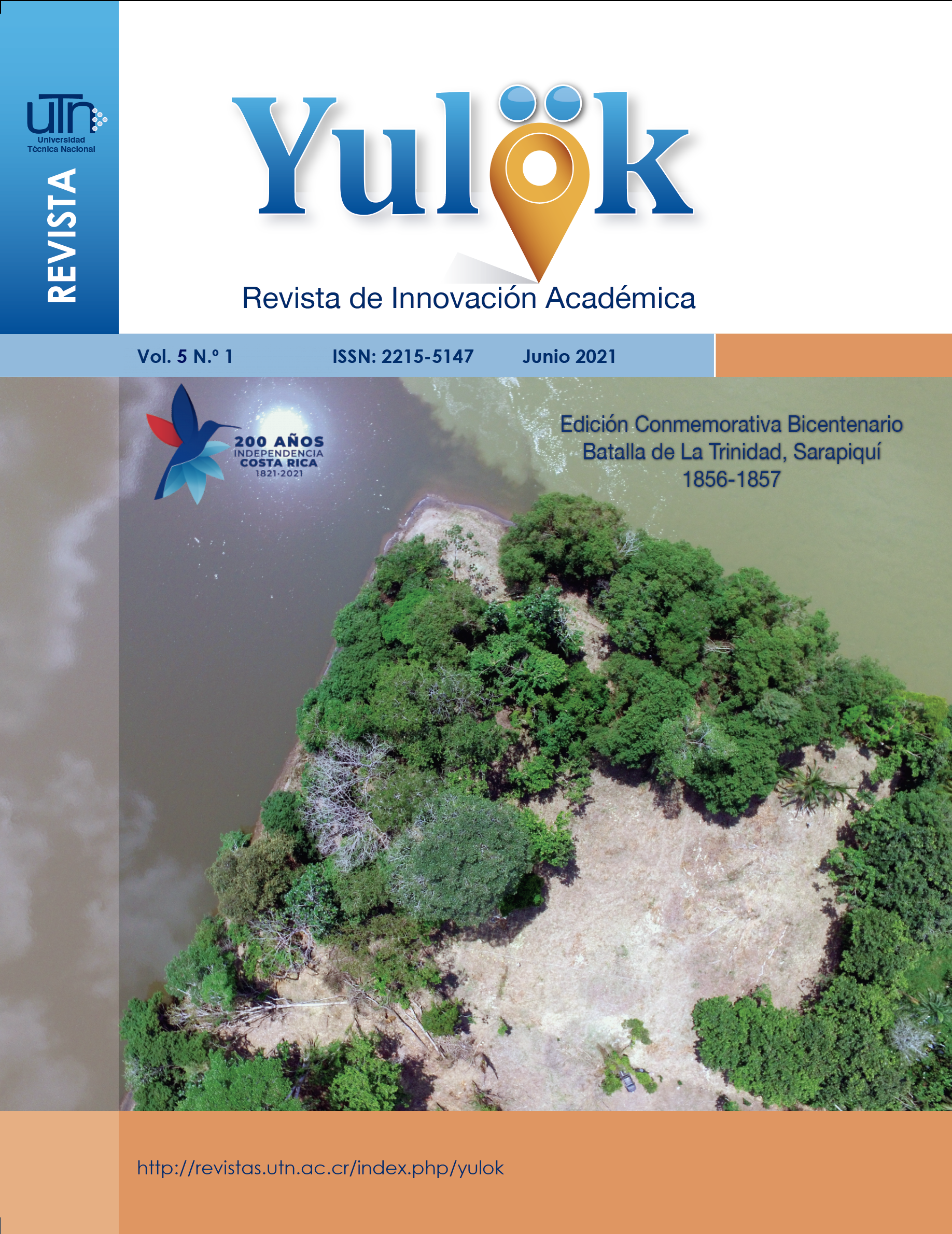Microstructural and elemental study of a bullet from the Battle of Trinidad de Sarapiquí in 1856
Main Article Content
Abstract
This study aims to generate a multidisciplinary understanding about the complexity of the historical battle in La Trinidad de Sarapiquí de La Campaña Nacional of 1856-1857, particularly in establishing a baseline diagnosis of the macrostructure, microstructure and elemental chemical analysis of a Minié bullet recovered from this historical event. We therefore carried out the first pilot study of a Minié ball recovered in 2016 in an excavation at the site of La Trinidad, in Sarapiquí, belonging to the Museo Histórico Cultural Juan Santamaría. In order to obtain information on both its internal and external structure, the techniques of optical microscopy, scanning electron microscopy and elemental analysis by energy dispersive X-rays were used to determine areas of interest in the bullet and also to specify the composition of the white patina which contains primarily three types of elements: Pb, C and O. Here, we identify the possible presence of cerussite crystals in the lead carbonate surface coating in a 165-year-old Minié bullet. It should be noted that knowing the rifle of origin and its bullet is evidence of great importance to contribute to the reconstruction of the historical context in which this event took place and will therefore allow us to establish which artifacts were being used at the time, both by national and Central American adversaries.
Article Details

This work is licensed under a Creative Commons Attribution-NonCommercial-ShareAlike 4.0 International License.
Todos los artículos publicados están protegidos con la licencia Creative Commons Atribución-NoComercial-CompartirIgual 4.0 Internacional
![]()
How to Cite
References
Amaya, Y., Muñoz, R. y Quiñones, J., (2008). Análisis de fragmentos arqueológicos del lago de Valencia mediante microscopía óptica de polarización, microscopía electrónica de barrido y difracción de rayos X. Bistua: Revista de la Facultad de Ciencias Básicas, 6(2), 1-8.
Arenas, J., Rendón, L., Cañetas, J., Zorrilla, C., y Silva, Y. (2015). Aplicación de técnicas de microscopía electrónica al estudio de material de origen arqueológico y de obras de arte. Instituto Universitario De Restauración Del Patrimonio De La UPV ,Instituto de Física UNAM,(20-364),149-156.
Arias Sánchez, R. (2007). Los soldados de la Campaña Nacional (1856-1857). Editorial Universidad Nacional a Distancia. https://books.google.co.cr/
Arias Sánchez, R. (2013). Juan Rafael Mora y las tres fases de la Campaña Nacional. Revista Comunicación, 19(Especial), 60–68. https://doi.org/10.18845/rc.v19iEspecial.947
Arp, D. (2002). Battlefield Oddities: Explaining two minié balls from Pea Ridge National Military Park. Nebraska Anthropologist, 69, 1-6.
Barrantes-Madrigal, M., Zúñiga-Salas, T., Arce-Tucker, R., Chavarría-Sibaja, A., Sánchez-Solís, J., Mena-Vega, J.,. Acuña-Umaña, K., Gómez Tencio, M., Wang-Qui, K., Lizano-Sánchez, F., Marín-Cruz, C., y Herrera-Sancho, O. A. (2021). Revealing time’s secrets at the National Theatre of Costa Rica via innovative software for cultural heritage research. Scientific Reports, 11(8560). https://doi.org/10.1038/s41598-021-88066-1
Bohn, H.L., B.L. McNeal y G.A. O’Connor. (2001). Soil Chemistry (3ed). John Wiley and Sons Inc. USA.
Burton, J. (1855). The Minie and the American expanding bullets. Scientific American, 10(21).
Chen, M., Daround, S., Ma, L., Harris, W., y Cao, X. (2002). Characterization of lead in soils of a rifle/pistol shooting range in central Florida, USA. Soil and Sediment Contamination: An International Journal, 11(10), 1-17. https://doi.org/10.1080/20025891106664
Dougherty, P., y Collins, H. (2009). Wound ballistics: Minié ball vs. full metal jacketed bullets: A comparison of Civil War and Spanish-American war firearms. Military Medicine, 174 (4), 403-407. https://doi.org/10.7205/MILMED-D-02-2307
Edwards. WB. (1962). Civil war Guns. The Stackpole Company, USA.
García, M. (2012). Deterioro químico de geomateriales. Instituto de Historia (CCHS-CSIC). https://1library.co/document/yr8mkjjz-deterioro-quimico-de-geomateriales.html
Jorgensen, S. y Willems, M. (1987). The fate of lead in soils: the transformation of lead pellets in shooting-range soils. Ambio, 16(1), 11-15. https://www.jstor.org/stable/4313312?seq=1
Knechtenhofer, L., Xifra, I., Scheinost, A., Flühler, H., y Kretzschmar, R. (2003). Fate of heavy metals in a strongly acidic shooting-range soil: small-scale metal distribution and its relation to preferential water flow. Jornal of plant nutrition and soil science, 166(1), 84–92. https://doi.org/10.1002/jpln.200390017
Leal, A. (2019). Caracterización de artefactos metálicos arqueológicos de excavación de la zona de Yaguachi Ecuador mediante microscopía [Trabajo de titulación presentado como requisito para la obtención del título de Ingeniero Mecánico,Universidad San Francisco de Quito USFQ]. Universidad San Francisco de Quito USFQ.
Li, Y., Zhu, Y., Zhaob, S. y Liu, X. (2016). The weathering and transformation process of lead in China's shooting ranges. Environmental Science Processes & Impacts, 2015(17), 1620–1633.
Museo Histórico Cultural Juan Santamaría. (2021). Visión y misión. https://www.museojuansantamaria.go.cr/
Rooney C., McLaren R., y Condron, L.(2007). Control of lead solubility in soil contaminated with lead shot: effect of soil pH. Environmental Pollution, 149(2), 149-157. https://doi.org/10.1016/j.envpol.2007.01.009
Sánchez, M y Novoa, E. (2018). Recuperación e interpretación de la evidencia cultural de la Batalla de la Trinidad durante la Campaña Nacional de 1856-1857, Sarapiquí.
Scott, D. (2004). Analysis of a .54-caliber Minie ball from the Immanuel Church, Pilot Knob,Missouri. Lincoln, NE.
Sanderson, P., Naidu, R., Bolan, N., Bowman, M., M., McLure. (2012). Effect of soil type on distribution and bioaccessibility of metal contaminants in shooting range soils. Science of The Total Environment, 438, 452-462. https://doi.org/10.1016/j.scitotenv.2012.08.014
Sistema de información cultural de Costa Rica. (6 de junio de 2021). Museo Histórico Cultural Juan Santamaría. https://si.cultura.cr/infraestructura/museo-historico-cultural-juan-santamaria.html
Zalakain, I., Berlanga, C., Alvarez, L., Asa, L., Labé, P., Rivero, P., Valencia, J., y Rodríguez, R. (2017). Characterization of two iron bullets from the royal ammunition factory of EUGI. Journal of Mining and Metallurgy Section B: Metallurgy, 54(1), 91-99.

